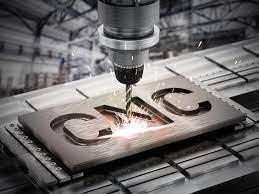Computer Numerical Control (CNC) machining has revolutionized the manufacturing industry by offering precise, efficient, and automated machining processes. In this article, we will delve into the world of CNC machining, exploring its definition, working principles, advantages, and its impact on the manufacturing sector.
-
Definition and Working Principles: CNC machining refers to a manufacturing process where pre-programmed computer software controls the movement of machinery and tools. It replaces manual operation with automated commands, allowing for highly accurate and repeatable machining operations. The process involves several key components, including the CNC machine, cutting tools, workpiece, and CAD/CAM software.
-
CNC Machining Process: The cnc machining process involves several steps, from design to the final product. Here is an overview of the key stages:
a. Design: The process begins with the creation of a 3D model using Computer-Aided Design (CAD) software. The model defines the dimensions, geometry, and specifications of the desired part.
b. Programming: Once the design is complete, Computer-Aided Manufacturing (CAM) software is used to generate the toolpaths and instructions for the CNC machine. The software translates the design into machine-readable code (G-code) that guides the machining process.
c. Setup: The workpiece is secured on the CNC machine's worktable, and the appropriate cutting tools are loaded into the machine's tool turret or spindle.
d. Machining: The CNC machine follows the pre-programmed instructions, controlling the movement of the cutting tools in multiple axes (typically 3-5 axes) to shape and refine the workpiece. The machine's precision and repeatability ensure accurate and consistent results.
e. Finishing and Inspection: After the machining process, the finished part may undergo additional processes such as deburring, polishing, or surface treatment. Quality control measures, including dimensional inspection and testing, are conducted to ensure the part meets the desired specifications.
- Advantages of CNC Machining: CNC machining offers numerous advantages over traditional manual machining techniques, making it the preferred choice for many manufacturing applications. Some of the key advantages include:
a. Precision and Accuracy: CNC machining delivers high levels of precision and accuracy, often achieving tolerances within a few thousandths of an inch. This level of precision ensures consistency and quality in the manufactured parts.
b. Efficiency and Speed: CNC machines can operate continuously, 24/7, resulting in faster production cycles and reduced lead times. Additionally, the automation of tool changes and workpiece repositioning further enhances efficiency.
c. Flexibility: CNC machines can produce a wide variety of parts, ranging from simple to complex geometries. The ability to switch between different designs and materials with minimal setup time makes CNC machining highly flexible.
d. Complex Geometries: CNC machining allows for the production of intricate and complex geometries that may be challenging or impossible to achieve with manual machining techniques. This enables the creation of innovative and intricate components.
e. Reproducibility: With CNC machining, once a part is programmed, the same program can be reused to produce identical parts consistently. This reproducibility is crucial for industries that require large quantities of precisely machined components.
- Impact on the Manufacturing Industry: CNC machining has had a transformative impact on the manufacturing industry. Some notable effects include:
a. Increased Productivity: CNC machining has significantly improved productivity levels in manufacturing, enabling faster production rates, reduced downtime, and increased overall efficiency.
b. Enhanced Quality Control: CNC machines produce parts with exceptional precision, minimizing errors and variations. This improves quality control measures, reduces scrap rates, and ensures consistency in the final products.
c. Cost Reduction: While initial investment costs for CNC machines may be higher, the overall cost of production is reduced due to increased efficiency, reduced labor requirements, and minimized material waste.
d. Innovation and Design Freedom: CNC machining has opened doors to greater design freedom, allowing for the creation of complex and unique parts that were previously challenging to manufacture. This has fostered innovation and product development across industries.
e. Skill Requirements and Workforce: The shift towards CNC machining has changed the skill requirements for manufacturing jobs. While manual machining required specialized skills, CNC machining demands proficiency in programming and machine operation. This has led to a change in the composition of the manufacturing workforce.
Conclusion: CNC machining has revolutionized the manufacturing industry, offering unparalleled precision, efficiency, and automation. Its ability to produce complex parts with high repeatability has transformed various sectors, from aerospace and automotive to electronics and medical devices. As technology continues to advance, CNC machining will likely remain at the forefront of manufacturing, shaping the future of production processes.
